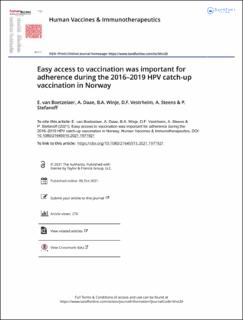| dc.description.abstract | Between September and October 2019, the Norwegian Institute for Public Health (NIPH) surveyed women born between 1991 and 1996 who were offered catch-up vaccination for human papilloma virus (HPV). The aim was to identify determinants of vaccine schedule adherence. A random sample of 10,000 women who were offered catch-up vaccination were invited to participate in the survey. We defined adherence as receiving all three doses. Determinants of HPV vaccination adherence were investigated using descriptive, univariable and multivariable logistic regression analyses providing adjusted odds ratios (aOR). Data from 3,762 respondents who received at least one dose were included. Overall, 92.1% (95% CI = 89.3–91.9) of those initiating vaccination adhered to the complete schedule. The following factors were significantly associated with HPV vaccination adherence compared to non-adherence: country of origin (aOR = 0.43; 95% CI = 0.47–0.97), having children (aOR = 0.51; 95% CI = 0.35–0.73), ease of finding out where to get vaccinated (aOR = 1.94; 95% CI = 1.69–2.23), preference for receiving information from health authorities (aOR = 1.37; 95% CI = 1.04–1.81) and vaccination being readily available (aOR = 2.28; 95% CI = 1.50–3.37). Information from NIPH via SMS and social media were negatively associated for Norwegians (aOR = 0.68, 95% CI = 0.46–1.01) and positively associated for those whose country of origin was not Norway (aOR = 1.48, 95% CI = 0.69–3.14; not significant). Those who did not adhere to the full vaccination schedule reported that they had forgotten (40.4%; 95% CI = 33.5–47.8) or had no time (32.9%; 95% CI = 26.2–40.4). Despite NIPH’s targeted communication campaign, the main barriers for HPV vaccination adherence were difficulty to find out where to get the vaccine, forgetting to take the vaccine or not having time to complete the schedule. | |
